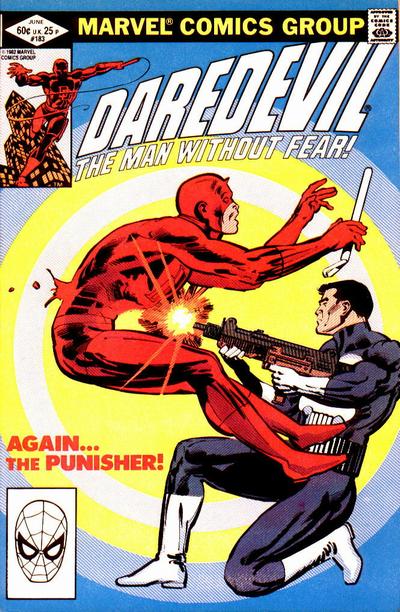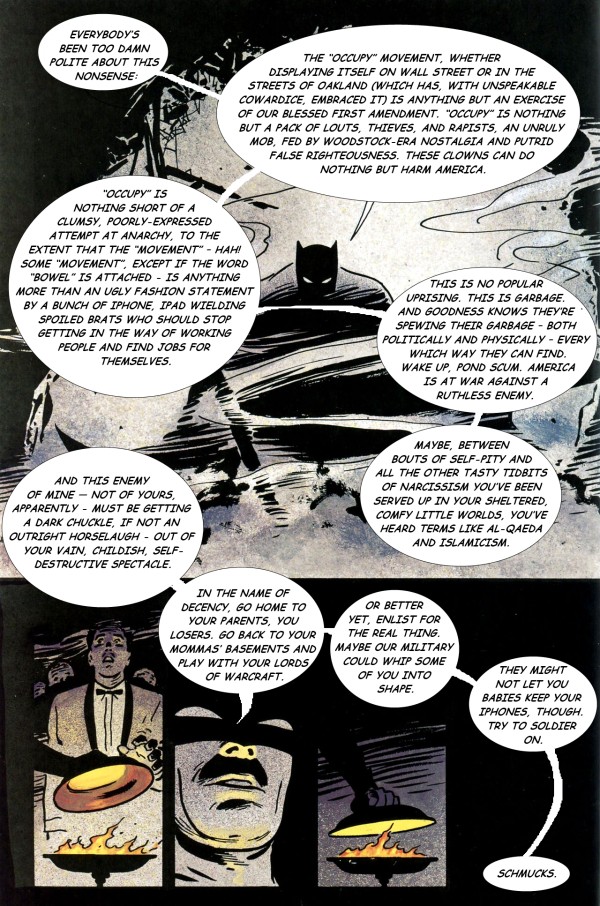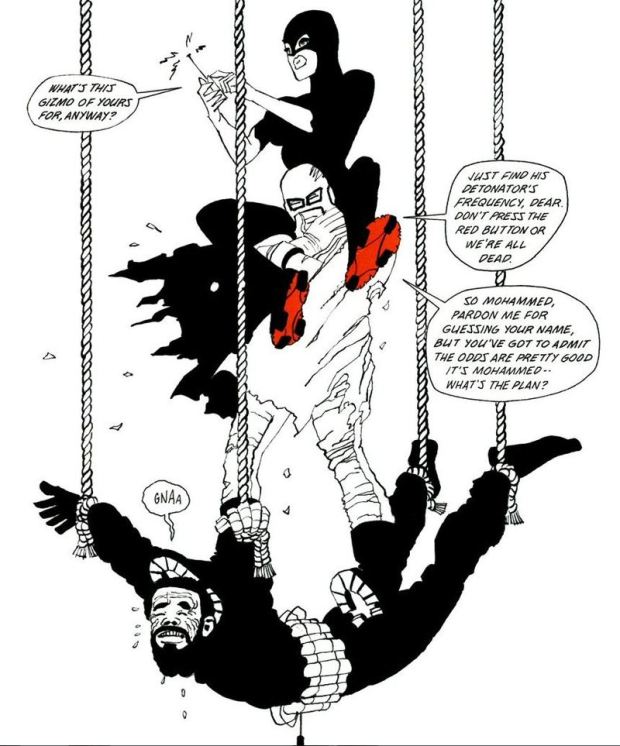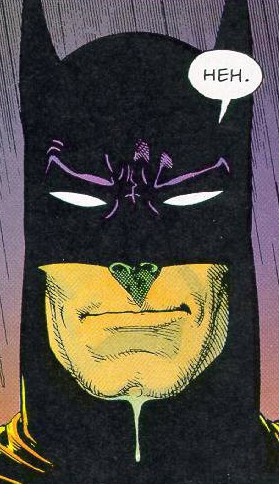I found this old diary of mine a while ago, when sifting through piles of half-forgotten books and newspaper cuttings and notebooks. It was from 1997. In the diary, I had listed names that inspired me, cheesy as it may sound. Number 1 on the list was this composer from South India. Number 3 was a comic writer and artist named Frank Miller.
I met Frank Miller yesterday. “Met” would be too strong a term, I guess. We did not exchange words with each other; I am not even sure we made eye contact. I guess it would be fairer to say that I was in the immediate vicinity of Frank Miller, with an interaction that bordered on the semi-transactional. Which is to say that I passed him two of my books, and he scrawled his signature on both of them. Desperate to instill some significance into this special moment, I tried to say something to Frank – but I was distracted by the assembly line feel of the signing. (The same thing happened with Stan Lee at the Hammer too, last year. Which reminds me that Stan the Man also turned up at the signing, to cheers and applause. “Who would win in a fight, Superman or Captain America?”, he asked Miller. He then proceeded to announce to the crowd that Miller would make an appearance at Comikaze 2016, which is Los Angeles’s own comic convention) The act of signing was a quick, mechanical flourish of the pen, with Frank’s hands already moving to my pal Sasi’s books right behind me – er, which were also technically my books. [ref]Sasi was there because I had called him a few hours earlier. He must have heard the note of panic in my voice as I tried to calmly tell him that Frank Miller was signing at the Grove, and that there was a two-book limit, and would he please come along so that I could get an additional book signed too, and he agreed. [/ref] But I get it, it was a long line, and really, Frank Goddamned Miller does not owe me anything. Yet…
Like most of the things that interested me early on in life, Frank Miller was a name that popped up in letter columns of comics. In ads for assorted comics, like The Dark Knight Returns, and Batman Year One, comics published in the early-to-mid 80s that made their way to small cities in North-Eastern India by some strange rules of supply and demand and happenstance.
Miller. Frank Miller. Klaus Janson and Frank Miller. Frank Miller and Lynn Varley. Frank Miller and Bill Sienkiewiecz. Frank Miller and David Mazzuchelli. The names of his collaborators got more and more grueling for my tongue, and the urge to read a Miller comic got even worse.
A page in What If 34. “What if Daredevil was Deaf Instead of Blind?” Played for laughs, but a fight scene that stayed in my mind. A short story in What If 35, “What If Elektra Had Lived?”, where I figured out the story of what had happened to Elektra (um, yeah, Bullseye kills her, Matt is heartbroken, life goes on) from an alternate reality story. I loved the brief snippets of art I saw, especially the dynamic, minimalist images of Daredevil running towards you. The mood and the way light and dark intersected in the panels. It felt very different from the comics I was used to.
Much later, I would meet Silver Age fans and see their reverence for Jack Kirby and Neal Adams. I never got Kirby art; Adams was fun, but a little dated. But I remembered my reaction to Frank Miller, and understood how that generation of fans must have reacted to Kirby.
A friend in school gave me my first Daredevil comic by Miller. It was one of the later issues, ‘Child’s Play’, where DD goes against the Punisher (also my first introduction to the latter). Everything about that issue is etched in my mind. The cover, where DD is shown flying back from a shotgun blast, his face frozen in surprise. The Punisher kneels on the other side of the page, with shotgun in his hand, a mean look on his mug. “Again…the Punisher”, screams the cover. The story begins with a scene that unfolds in a classroom, featuring a goose-bump inducing narration of drug abuse. The sequence of events that follow spiral out from school to a hospital to a courtroom and beyond, where Matt Murdock is to defend a criminal who has been wrongly accused of peddling drugs to kids. Wrongly accused because he can hear the Hogman’s heartbeat when he protests that he is innocent. The visual tics were incredible. We see the Punisher’s arms first, doing pushups in – I dunno – a loft? There’s a TV in the room, talking about Matt’s defense. The man stops exercising, and pays attention to the news report. You know something’s going to happen. The themes that I encountered in these stray Miller stories are familiar chords that the creator plays with, and improvises on, again and again. [ref]The role of television as a parallel narrative, in particular, is something that the creator employed to great effect in his later work. [/ref]There were fight sequences on rooftops that did not feel like a superhero fracas at all. The comics I had been used to were Eastmancolor narratives, all sun and summer and optimism. Miller’s Daredevil felt different, the equivalent of seeing a hand-held camera sequence for the first time. I would learn the word “gritty” much later, and I remember how apt it felt, to sum up what I was taking in back then.

Cover to Daredevil #183 by Frank Miller
Would I have said anything to Miller? Would I have liked to talk to him in detail? Of course I would. But I was worried too. It is worrisome when someone you look up to does things that are at odds with your worldview, and the zeitgeist of the times. Frank Miller’s career choices and outlook seem irreversibly tinged with the events of September 11, 2001. Before 9/11, Miller was angry, but his anger seemed to be cast in a noble, somewhat naive view of who the Good Guys were; people weren’t just bad, they were Downright Despicable. The book of interviews Eisner/Miller brings this aspect of Frank Miller into sharp focus. Here he is, this guy of the 70s and 80s, talking to an old-timer in the comics industry who was right there in the Golden Age of Comics. Miller is raging against unfair practices of the sweatshops and how Siegel and Shuster were treated badly and how Bob Kane is the worst person in the history of comics. Eisner on the other hand tries to say that it’s not all black-and-white, that things were not that clear-cut, and that makes Miller blink once or twice (metaphorically, of course), but he sticks to his narrative. It’s all somewhat bizarre, but it also made me take pause and re-evaluate Miller – in particular his rage-filled commentary in the letters pages of Sin City, a series I had painstakingly collected issue by issue right after graduating from college.
But post-9/11 Miller, boy-oh-boy. Go no further than Holy Terror, to understand how Miller’s ideas about Us vs Them, Good vs Evil solidified into something that is so blindly ideological and full of blatant racism. All Star Batman starts off as a fuck-you to rabid fans, featuring train-wreck scenes that give people what they want, amped up to 11 thousand, but there is only so much of mischief-mongering one can take. But what really made you take pause was Miller’s Anti-Occupy-Wall-Street rant on his (now-under-construction) website. This is the text, juxtaposed over an iconic scene from Batman: Year One.

Text by Frank Miller, originally drawn by David Mazzuchelli for “Batman: Year One” (1986) Source: http://io9.gizmodo.com/5859038/frank-miller-slams-occupy-wall-street-becomes-a-parody-of-himself
Oh-kay, Frank.
Add to these missives from cuckoo-land the fact that Miller’s drawing skills were deteriorating as the years went by. The first few pages of Holy Terror were the ones advertised by the media – they were gorgeous swathes of black and white that captured the man’s anger and grief, or so I think. But by the time the book came out 10 years later, nearly everything had changed. The rest of the book is near-stream-of-consciousness story – and I use that word with more than a hint of irony – propped by artwork that is at best Miller-Lite, and at worst, pen-and-ink excretions. Gone was the growling voice and the words that made you quiver. What remained was an angry old man and his bitterness. This is how heroes dissolve in your eyes.

DC Comics however still finds in Miller a well of potential, but that is more to do with DC’s market base, sheep people who buy into the nostalgia of a few decades ago and want more of what they read when they were sixteen, back in 1985. DC’s biggest hit from last year was a comic called Sandman: Overture, which featured a prequel to a best-seller from the 80s. Their attempt to capitalize on a travesty called Before Watchmen did not work out well[ref]With the petulance of a child that can legitimately say “I told you so”, I gaze at bargain bin sections of bookstores, filled to the brim with unsold hardcovers of BW, and I whisper “Yes”.[/ref], but that does not stop them from trying out a similar exercise with the third in that trinity – The Dark Knight Returns. The only smart thing that they managed to do was to put a different writer-artist team in charge of the actual book. Miller is around as a creative consultant and plotter, but is understandably hands-off the project, making his appearances and walking up to the podium to talk about how happy he is with continuing a story that he had intended to be “the final Batman adventure”. What he has done for this series is a mini-comic, whose cover does not flatter Superman. But there are always defenders, obviously. Because art, right? [ref]For the record, I do not think Miller intends to draw clunky, minimalist lines as a stylistic choice. I think he *cannot* draw anything but clunky lines.[/ref]
Happily, most of the authors I grew up on are great human beings. Their humility and graciousness make me feel good about liking their art, and while the Internet Age has made some of their mystique go away, I am always in favor of walking up to a creator, look them in the eye and thank them for the joy and wonder they brought into my life and many others. From what I have seen, this simple act is a Good Thing. I wish I could have done the same thing with Frank Miller. It feels like Miller 2016 is impeded by his inability to live in the real world I inhabit, where nuance is preferred to knee-jerk reactions; and where people of influence are mindful of how their words play out in a troll-infested garden. Or maybe my tastes have changed, and it is simply not possible for me to separate an artist’s work from the artist as an individual any more. Mostly because there is a lot of art around me, and I can afford to pick my spot. The signing was important as an item on my bucket list, getting the books signed themselves was not. [ref]I mean, I own a signed/limited copy of the Graphitti Edition of Ronin, a gargantuan volume that nearly broke my back as I hauled it home from San Jose last year. [/ref] It is just that Miller and his current work feel irrelevant in my life right now.
A sort of epilogue, I suppose. I spent part of Sunday rereading The Dark Knight Returns. It was as emotional an experience as it was those many years ago. I do find myself taking away different things from it, and probably would like to talk about the work some time. I am still a fan, 1986-Frank-Miller; I hope you are okay with the fact that I cannot deal with your work any more. [ref]Hubris. He does not (and should not) care.[/ref] [Previously on Frank Miller, during the release of Holy Terror.]
